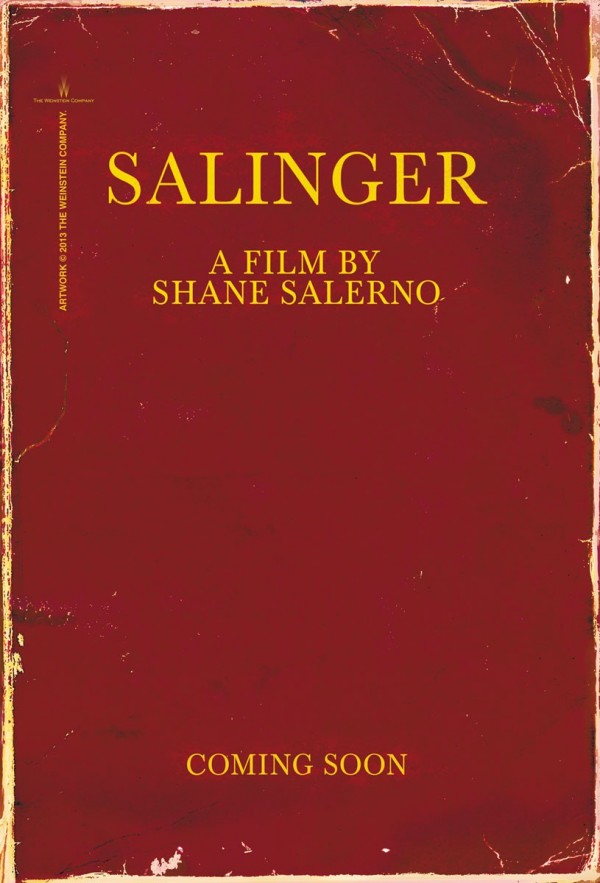SALINGER (2013, directed by Shane Salerno, 129 minutes, U.S.)
 BY DAN BUSKIRK FILM CRITIC It’s a little hard to fathom the critical animosity this absorbing documentary on legendary writer J.D. Salinger has received, except to conclude that writers still feel the need to protect lonely old Holden Caufield. The notoriously reclusive author of Catcher in the Rye and Franny & Zooey didn’t leave behind a whole lot of evidence of his private life, but Salerno puts together the pieces to present the trajectory of a great fiction writer but he also paints an unflattering picture of a man whose disgust for the insincerity of the world ultimately curdled into a rejection of his public.
BY DAN BUSKIRK FILM CRITIC It’s a little hard to fathom the critical animosity this absorbing documentary on legendary writer J.D. Salinger has received, except to conclude that writers still feel the need to protect lonely old Holden Caufield. The notoriously reclusive author of Catcher in the Rye and Franny & Zooey didn’t leave behind a whole lot of evidence of his private life, but Salerno puts together the pieces to present the trajectory of a great fiction writer but he also paints an unflattering picture of a man whose disgust for the insincerity of the world ultimately curdled into a rejection of his public.
The poetry of the man is missing, mainly because the film did not have the rights to quote his work, leaving Salinger at a loss to color in the brilliance of the man at his best. Without that counter-balance the film might come off as a hit piece, but the producers must have taken for granted that most of his audience would have that information from one of the 60 million copies of Catcher currently in circulation. While perhaps short-sighting his genius, Salinger does us all a service by dragging his life into the sun and bringing together the facts we know in order to give insight into one of the most highly-influential figures of the 20th century.
Like many documentaries, it is the rise of the subject that is most thrilling. Salinger’s early discovery of his talents at the Valley Forge military academy in the ’30s, his unshakable belief in the depths of his abilities as a writer and his dogged, sisyphean pursuit to get published in The New Yorker give us a giddy picture of a master gathering his powers. This ascent was interrupted when Salinger enlisted in World War II. Salinger was romancing the beautiful 16-year-old débutante daughter of playwright Eugene O’Neill, a young woman he would lose while on the battlefield to a fellow nymph-lover, Charlie Chaplin. Yet heartache would be the least of Salinger’s troubles as he is thrust into some of the most soul-crushing experiences of the war, seeing the existential horror close-up while hitting the beach on D-Day and later liberating the German death camps. Salinger was part of a quartet of  soldiers who were buddies for life and hearing one of those soldiers discuss his own lingering trauma gives a window into the PTSD with which Salinger must have struggled.
soldiers who were buddies for life and hearing one of those soldiers discuss his own lingering trauma gives a window into the PTSD with which Salinger must have struggled.
When he returns from the war, Salinger channels that psychic holocaust into his writing and Catcher finally makes him a literary star upon its release in 1951. Salinger seems to sense early the corrosive emptiness that was being unleashed by the celebrity and consumer culture of the second half of the 20th century, leading to him disappearing into hermitage in the White Mountains of rural New Hampshire. While there he seems to find a paradise lost in the innocence of young, unformed teen girls. There was a series of them in his life, all beneath him in power, wisdom and experience and their relationships seem to falter quickly at any sign that the girls are finding their way into womanhood. These are unpleasant facts that seem most disheartening to Salinger’s fans, and their anger has been taken out on women like writer Joyce Maynard, who was summoned to Salinger’s New Hampshire home in 1972 when the New York Times put her on the cover of the Sunday magazine at the age of 18. Fans are outraged that Maynard would betray his confidence, but there seems to be a lingering sexism that underlies their perspective that she has no right to comment on the experiences of her own life. There is no reason to doubt any of their intimate details and it is hard to deny that the psychological ramifications of their stories reveal something deeply unflattering about the inner turmoil of Salinger.
“You know what your problem is, you love the world” Salinger is said to have yelled at a departing lover, and perhaps this display of misanthropy is too much to enjoy when placed on the back of a beloved sensitive novelist. Within Salinger, it seems Holden Caufield has grown up from disillusion to bitterness, hardly an uplifting or satisfying trajectory.
Yet the film has an upbeat finale, giving heretofore unknown info about Salinger’s literary trust, which has been tasked with a specific publication schedule for his unreleased works starting in 2015 and ending in 2020. The works all stem from Salinger’s experiences as a young man, with no sign that he found anything inspiring in his recluse years. Turns out J.D. is no Sugar Man; where people loved last year’s doc about Rodriguez, the 70s folk rocker who returned to glory, Salinger discusses the darker dimensions of seclusion. Critics can complain about the film’s brief illustrative re-enactments or the story’s more sordid details, but its the film’s grimmer conclusions about the beloved author that keeps Salinger from being the crowd-pleaser people might yearn for. Few critics could resist putting the film down for being “phony” but my suspicion is that for most the problem is that Salinger is not phony enough.
PBS’ AMERICAN MASTERS WILL BROADCAST “SALINGER” TONIGHT AT 9 PM

